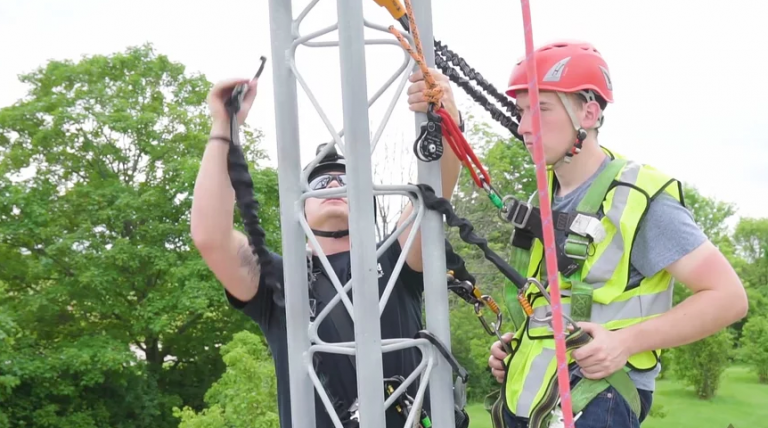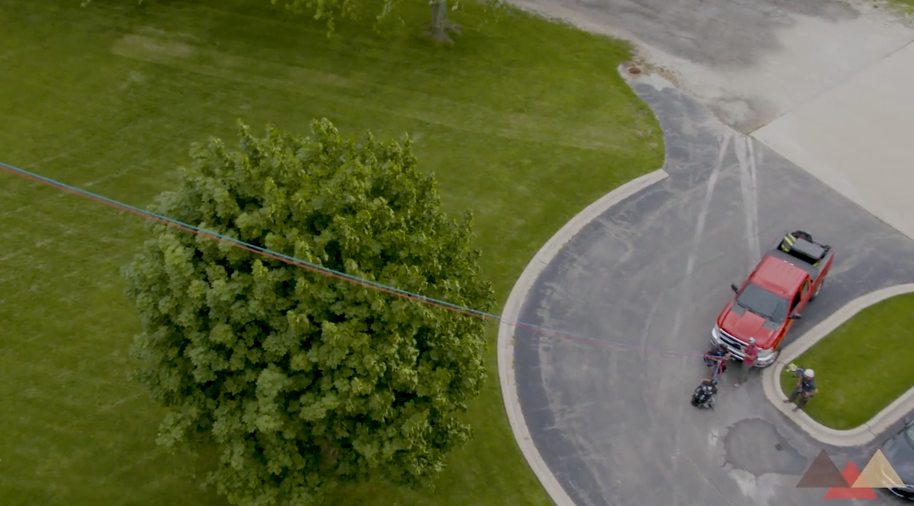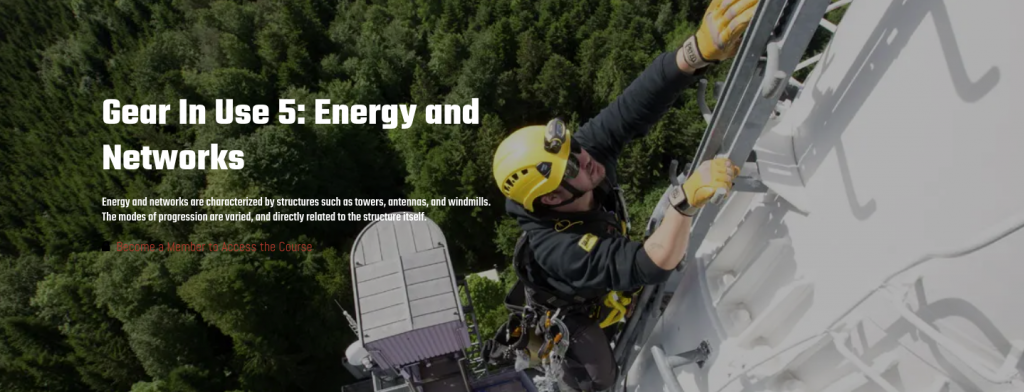Tower Control Systems
Tower Control relies on 1 or 2 rescuers climbing the structure with everything they need to facilitate the rescue up top.
-
Team Selection: Tower rescue is not for everyone. It is both physically and mentally demanding. Being on top of a 200 foot tall rooftop is a completely different feeling than being up even 60 feet on a fully exposed cell tower leg (like being on a ship at sea, towers MOVE under your feet). Your selection should be the two most highly trained members you have that are physically capable of climbing up the tower loaded down with the necessary equipment. Climbing is strenuous and burns a lot of calories, so rescuers should have food and water with them.
-
Rigging: All rigging should be prepared/setup on the ground as much as possible and kept as simple as possible. The two scenarios for tower rescue are:
-
Pick-off style rescue: Rescuers set up two static lines above the victim. One rescuer rappels down and performs a standard pick-off style rescue to the ground.
-
Top lower: Rescuers set up a two-rope system above the Subject, then make connections to victim and lower and belay from up top to the ground.
-
-
Rope Length: At least the height of the rescue, with some to spare. This is usually a determining factor to if you will do a tower control or ground control rescue. If the victim is at 180ft and all you have is 300ft long rescue ropes your choices are to do a tower control rescue or a ground control and pass knots.
-
Advantages: Fast, small rescue team (if they are highly trained), less rope and equipment needed.
-
Disadvantages: Small rescue team has all the responsibility, not for severe trauma patients, limited ability to offset away from the structure.
Tower Systems and Kits
Ground Control Systems
Ground Control relies on establishing a fixed brake on the ground rather than on the tower.
-
Team Selection: Two most highly trained members to climb tower to establish high point change of direction pulleys and to package victim. Because the control is on the ground the rescuers climbing have less responsibility than on a tower based rescue.
-
Rigging: Two rescue climbers will climb up utilizing a bag carry, end carry, or bight carry technique. They will establish high point change of direction pulleys, package patient if that is possible, and make appropriate connections. Ground will establish a lowering or raising system. Auto locking, rescue-rated descent control or progress capture devices (e.g. the Petzl I’D or CMC MPD) work best in this kind of scenario.
-
Rope Length: At least two-and-half times the height of your rescue. This will also vary based on the type of system is setup.
-
Advantages: Offset options to bring package away from structure, responsibility is spread among more members, space to run rigging for haul and lower as needed.
-
Disadvantages: more rope needed, more complicated, slower, more equipment needed, larger rescue team needed, solid communication is essential.
Peace on your Days
Lance












15 thoughts on “Tower Rescue: Tower Control Versus Ground Control”
363043 897015 warning Dont any of you individuals ever take me to CiCis pizza! There food looks offensive!|Urban_Elegance| 924888
I got good info from your blog
Hi, I think your site might be having browser compatibility issues. When I look at your website in Safari, it looks fine but when opening in Internet Explorer, it has some overlapping. I just wanted to give you a quick heads up! Other then that, fantastic blog!
Great post. I am facing a couple of these problems.
130914 48135 You should take part in a contest for one of the best blogs on the internet. I will recommend this website! 380433
512599 870304I likewise conceive thus, perfectly written post! . 15970
Appreciate you sharing, great blog post.Really thank you! Will read on…
720924 175932I enjoy your composing style, do carry on creating! I will probably be back! 81866
Hello just wanted to give you a brief heads up and let you know a few of the pictures aren’t loading properly. I’m not sure why but I think its a linking issue. I’ve tried it in two different web browsers and both show the same results.
968810 325664I dont agree with this certain post. However, I did researched in Google and Ive located out that you are correct and I had been thinking inside the incorrect way. Continue producing quality material similar to this. 163027
Sabah dayak yerdim. ıslanmasın diye üzerine geçirdiğim mavi
naylon ıslak çorap ve eldivenlerimizi kömür sobasında kurutur.
Yay google is my queen helped me to find this outstanding site! .
Rüyada cinsel ilişkiye girmek kişinin tüm ideallerinin ve hayallerinin gerçekleşeceğine delalet eder.
Fakat kişi tanımadığı ve bilmediği
biriyle cinsel ilişkiye girdiğini görürse.
5102 389697if this post was likened to a flavor of yogurt, what flavor would it be? Banana, I think. 408961
Very well written article. It will be supportive to anybody who employess it, including me. Keep up the good work – looking forward to more posts.
Comments are closed.